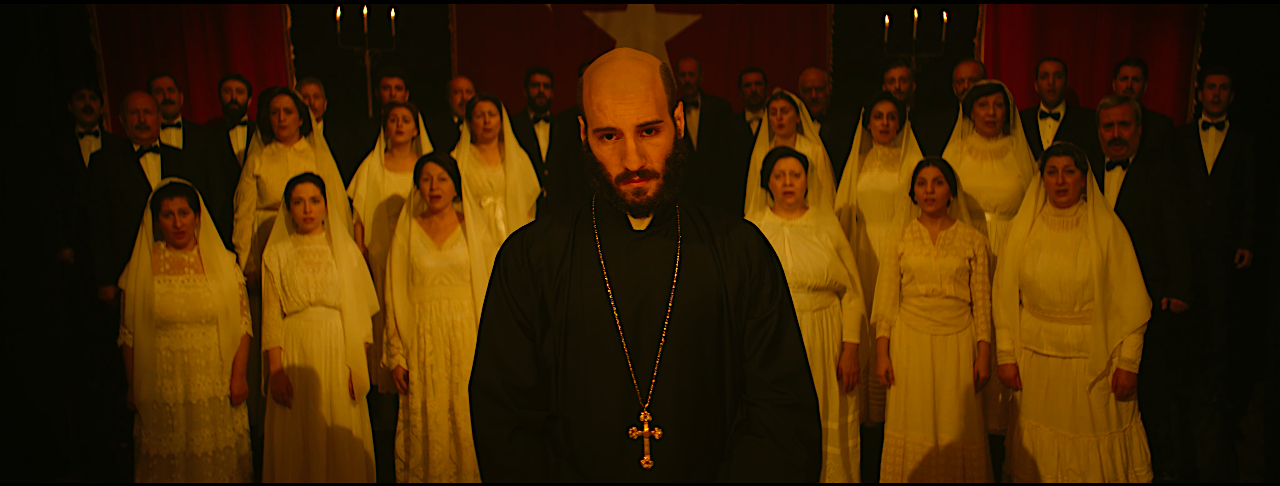
We seem to have the political will at the moment (even if only for a very brief moment) to address social inequities and allow justice and fairness to guide our decisions. One can fairly hope that this year’s golden statuette will “go to” Songs of Solomon—Armenia’s official entry for Best International Feature at the 93rd Academy Awards. Not only is the film relevant to what we are dealing with today, but it is also a powerful statement about the possibility of ending our divisive politics and the ensuing wars and violence that plague our lives.
Songs of Solomon depicts the life of the musical genius Komitas Vartabed in the years of the Hamidian Massacres that led to the 1915 Armenian Genocide. The plot centers around the friendship between an Armenian woman (Sona) and a Turkish woman (Sevil) living in Constantinople in the 1890s. The film gives us a close view of the daily lives of the two women. The details are illuminating and reveal the wider issues. The persecution of the Christian populace living in Constantinople points to the policies of extermination and the systematic cleansing of the Christian Armenian population living in Ottoman Turkey. Audrey Gevorkian’s script, based on a real-life story by Sylvia Kavoukjian, plays a key role here. Gevorkian’s insights into the time and place of the events greatly enhances the film’s credibility. The fear of the arrests is real. The scene in the marketplace where the Turkish colonel, a sarcastic smile on his face, smashes the delicately decorated Armenian pottery, chills one to the bones. There is no holding back. It is all true to fact. One does not suspect an intentional omission of the historical facts either. “As long as we keep it truthful, the story speaks for itself,” avers the filmmaker in a recent interview with the Armenian Weekly.
Arman Nshanian, a 20-year veteran of the opera and the theatre, passes the test of his movie directorial debut with flying colors. His respect for the script and the cast makes the film the powerful art that it is. The fledgling director has incredible empathy for his characters. Each is depicted with compassion and humanity. Young Solomon, the village boy with the divinely beautiful voice whom Nshanian, after having despaired almost, found in a remote village in Armenia, captures everybody’s heart. (“He could sing too! I was so happy, I kissed him on the head,” says Nshanian with much emotion during a recent UCLA screening.) Indeed, each character engages the audience with an award-worthy performance. All become the parts they play. Working with the young “actors” was especially challenging, confessed Nshanian.
No less appealing in the movie is the beautiful cinematography. The scenes in Kutahya—the village where Solomon, later Komitas, was born and where his connections with Sona and Sevil, then little girls, blossomed—are a visual treat. The scene with the flock of sheep returning home against the bright green background of the lush meadows is breathtakingly beautiful. It is all so rich and so subtle.
Komitas’ music is interwoven throughout. While the folk song Arev dsaketz captures the cheerfulness of the early morning sunrise, the more mournful and sacred songs that accompany the various scenes bring home the painful reality of the characters’ lives. Komitas’ music can be both heartwarming and heartbreaking.
Songs of Solomon may have an atmosphere of melancholy, but the movie is also an affirmation.
Referring to the recent Artsakh War, “Armenians cannot lose hope during this divisive time,” says Nshanian. Indeed, his movie affirms the power of love and of compassion to abolish the division. At a time when giving shelter to Armenians was punishable by law, Sevil hides her Armenian friend from the authorities, defying her husband and risking her own life. She later brings up Sona’s son as if he were her own. With his art Nshanian hopes to “elevate humanity,” while also bringing “global recognition and prestige to his Armenian heritage.”
Songs of Solomon is timely and relevant. The horror of war is still with us, and Nshanian depicts that horror honestly, forthrightly, never faltering in his promise of getting “the truth out there.” There is affirmation in confirming the truth.
The urge to reform will always be with us. The artist creates because it is impossible for her to sit back, watch the horror unfold, and do nothing about it. Songs of Solomon is an eloquent statement of the beauty of that creation prevailing. But the film is also Nshanian’s homage to the pain of his people. Our Truth is our Beauty, our Beauty our Truth.
Whether it chooses to play honest politics (the ultimate oxymoron?), or no politics at all, the Academy of Motion Picture Arts and Sciences owes Songs of Solomon the recognition it deserves.


Be the first to comment